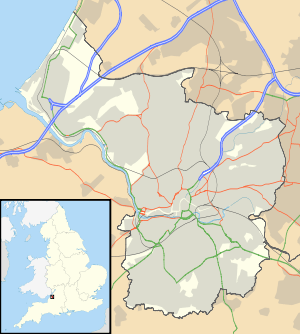Commercial Rooms, Bristol
The Commercial Rooms (grid reference ST587729) are in Corn Street, Bristol, England.
| Commercial Rooms | |
|---|---|
 Location within Bristol | |
| General information | |
| Town or city | Bristol |
| Country | England |
| Coordinates | 51.4545°N 2.5945°W |
| Completed | 1810 |
| Design and construction | |
| Architect | Charles Busby |
Built in 1810 by Charles Busby, the building has sculpture by J. G. Bubb. Originally it housed a club for mercantile interests and during the mid-19th century it was a haunt of local prostitutes. The retained wind vane [1] above the bar would let merchants know whether it was safe for their ships to negotiate the treacherous Avon Gorge, and the wall boards still contain the names of all the club's presidents, treasurers and secretaries. It is now a pub owned by Wetherspoons.[2]
History
The first formal site for businessmen to meet in Bristol was the Tolzey in 1614 which was built onto the south wall of All Saints' Church.[3] The Exchange was built in 1743, originally for use by all commercial businesses in Bristol but once the Commercial Rooms opened in 1808 the Exchange became the headquarters of the corn trade.[3]
The first president of the Commercial Rooms was John Loudon McAdam, inventor of tarmac, in 1808.[3] The first telegraph office in Bristol was established in the Commercial Rooms in 1852 with a telegraph line out to Shirehampton so that the messenger announcing ships entering the Bristol Channel no longer had to ride by horseback into the city.[3] After the Bristol Blitz in the Second World War conservation and restoration work was needed inside and out due to bomb damage, including recreating the head of one of the statues on the roof.[3]
In 1951 the Great Room featured a 'tape machine' which fed stocks and shares information to the room. In summertime this machine was also used to broadcast cricket scores.[3]
The building has been designated by English Heritage as a grade II* listed building.[4]
Archives
Records of the Commercial Rooms are held at Bristol Archives (Ref. 20164) (online catalogue 1) (Ref. 37454) (online catalogue 2), (Ref. 41504) (online catalogue 3), (Ref. 44059) (online catalogue 4), (Ref. 44759) (online catalogue 5).
Architecture and decoration
The portico is of the Grecian Ionic order, with the three statues above personifying the City, Commerce and Navigation.[3] Above the columns is a relief showing Britannia, Minerva and Neptune receiving gifts from earth.[3]
References
- "GertLush Online: Bristol local history website". Archived from the original on 20 September 2009. Retrieved 12 November 2009.
- "Bristol Pubs – The Commercial Rooms – a J D Wetherspoon pub". Retrieved 2 September 2017.
- Clarke, The Commercial Rooms 1811-1951, JW Arrowsmiths, 1951
- "No.43 Bristol Commercial Rooms and attached area railings". historicengland.org.uk. Retrieved 2 May 2007.